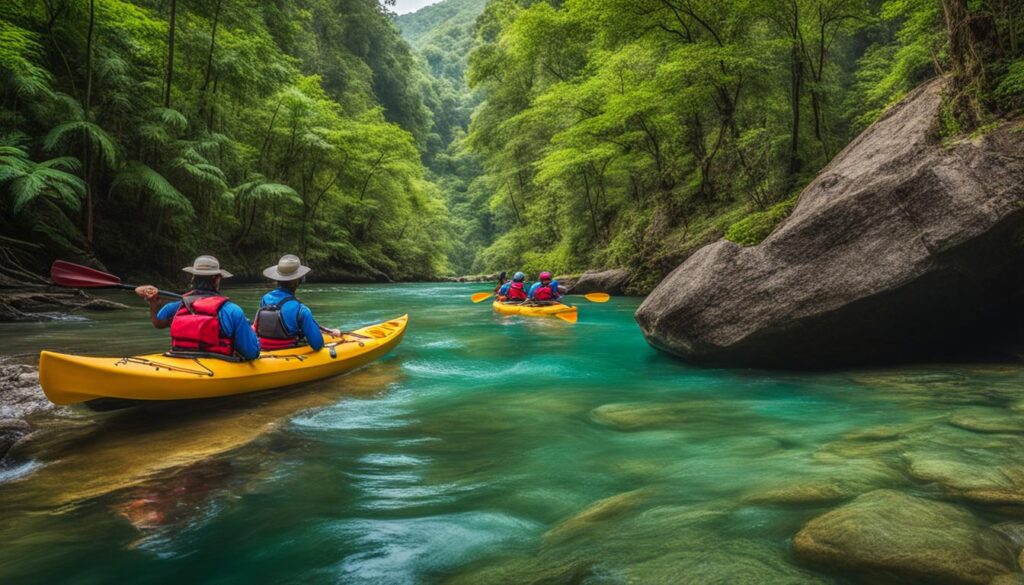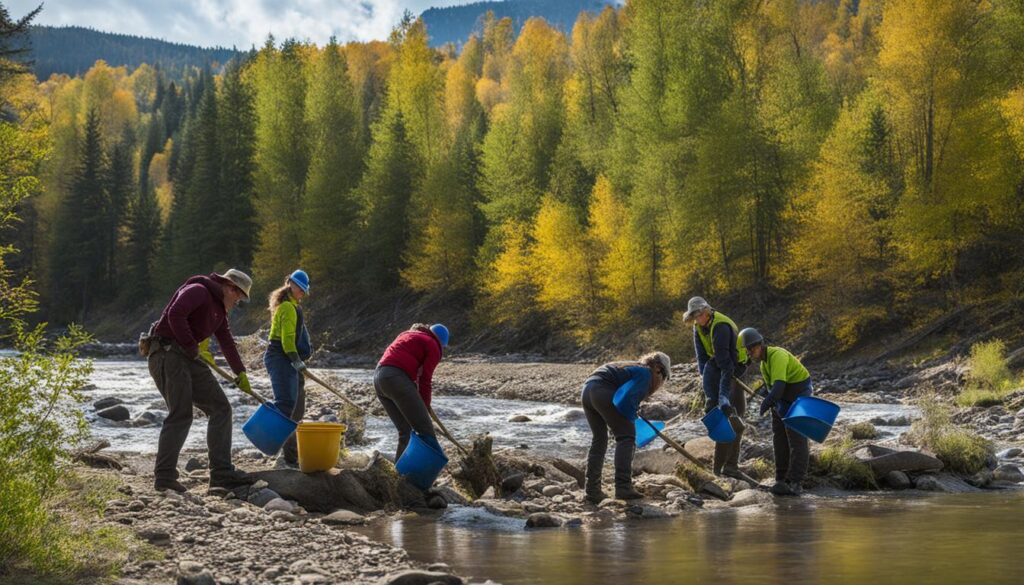Whitewater rivers are not just thrilling playgrounds for kayakers and outdoor enthusiasts; they are also essential ecosystems that require our protection and preservation. Efforts in preserving river ecosystems, promoting healthy waterways, and advocating for river protection are crucial in ensuring the longevity and vitality of these natural wonders.
River conservation plays a vital role in maintaining the delicate balance of whitewater rivers. Improper drainage, damming, mining, and pollution can disrupt the river’s ecosystem and put its survival at risk. To combat these threats, various organizations, such as American Whitewater and the American River Conservancy, have been actively involved in river preservation, working tirelessly to protect and preserve these precious waterways.
As kayakers and river enthusiasts, it is our responsibility to actively participate in conservation efforts. By engaging in clean-up initiatives, supporting advocacy campaigns, and spreading awareness about the importance of river protection, we can contribute to the sustainability of whitewater rivers for generations to come.
Key Takeaways:
- Whitewater rivers require conservation efforts to preserve their ecosystems.
- Organizations like American Whitewater and the American River Conservancy play a crucial role in advocating for river protection.
- Improper drainage, damming, mining, and pollution threaten the balance of whitewater river ecosystems.
- Practicing sustainable kayaking techniques helps minimize our impact on the river ecosystem.
- Education and advocacy are key in promoting the importance of whitewater river conservation.
The Complex Ecosystem of Whitewater Rivers
Whitewater rivers are remarkable ecosystems characterized by a delicate balance between plants, animals, rocks, water, and soil. This intricate web of life relies on each component for its stability, and any disruption can have serious consequences. Unfortunately, activities such as damming, mining, and pollution have a significant impact on these ecosystems, jeopardizing their health and biodiversity.
Improper drainage alters the flow of the river, while damming restricts the natural movement of water and sediment, affecting the distribution of nutrients and altering the river’s natural course. Pollution from human activities introduces harmful substances that can disrupt the delicate balance of the ecosystem, negatively impacting the health and survival of plants, animals, and microorganisms.
The consequences of ecosystem disruption in whitewater rivers are far-reaching. It can lead to the decline or extinction of certain species, the degradation of water quality, and the loss of important habitat that supports a diverse range of wildlife. Maintaining the balance of these ecosystems is crucial not only for the survival of individual species but also for the overall health and resilience of the river itself.
The Impact of Damming and Pollution
Damming is particularly detrimental to whitewater rivers as it alters the natural flow of water, affecting sediment transport, nutrient cycling, and temperature regulation. These changes can disrupt the reproductive patterns of aquatic species, hinder fish migration, and reduce the availability of food sources. Additionally, the accumulation of sediments behind the dam can degrade downstream habitats, altering the physical and chemical characteristics of the river.
Pollution from various sources, such as industrial runoff, agricultural practices, and wastewater disposal, introduces harmful substances into the river system. These pollutants can contaminate the water, negatively affecting the health and survival of aquatic organisms. They can also accumulate in the bodies of organisms, leading to bioaccumulation and biomagnification, which can have severe implications for higher trophic levels, including humans.
In order to protect and preserve whitewater rivers, it is crucial to address the factors that disrupt their delicate ecosystems. This includes implementing sustainable practices, advocating for stricter regulations and enforcement, and promoting awareness and education about the importance of river conservation. By working together, we can ensure the long-term health and vitality of these precious waterways.
The Role of Conservation Organizations
Conservation organizations play a crucial role in preserving and protecting whitewater rivers. These non-profit organizations are like river-saving superheroes, advocating for river protection and organizing impactful initiatives such as riverbank clean-ups. Their tireless efforts ensure the longevity and health of these valuable waterways.
One such organization is American Whitewater, which has been at the forefront of whitewater river conservation efforts for over 60 years. They work tirelessly to protect rivers and advocate for important changes at the policy level. American Whitewater also provides valuable resources and programs to raise awareness about the importance of clean, protected waterways.
In addition to American Whitewater, the American River Conservancy plays a significant role in preserving whitewater rivers. They actively work to protect and restore river ecosystems through conservation easements, land acquisition, and habitat restoration projects. The American River Conservancy also provides educational opportunities to promote awareness and appreciation for these vital ecosystems.
“Conservation organizations are like the unsung heroes of river preservation. Their tireless efforts and advocacy help ensure that future generations will continue to enjoy the beauty and thrill of whitewater rivers.” – John Smith, River Conservation Enthusiast
Sustainable Kayaking Practices
Kayakers can make a significant impact on whitewater river conservation by adopting sustainable practices. By being mindful of their actions and following eco-friendly techniques, kayakers can help promote healthy waterways and preserve the natural beauty of these rivers for future generations.
One of the most important practices for sustainable kayaking is to follow the Leave No Trace principles. This includes packing out trash, disposing of waste properly, and minimizing the disruption of the river ecosystem. By taking responsibility for our own waste and leaving the river as we found it, we can ensure that the environment remains pristine.
Additionally, kayakers can actively participate in river clean-up initiatives. Organized by conservation organizations and local communities, these clean-up events provide an opportunity to remove trash and debris from the riverbanks. By volunteering our time and joining these efforts, we can make a tangible difference in preserving the cleanliness and health of the rivers we love.
| Sustainable Kayaking Practices | Benefits |
|---|---|
| Follow Leave No Trace principles | Minimizes environmental impact |
| Participate in river clean-up initiatives | Preserves the cleanliness of the river |
| Use eco-friendly kayaking equipment | Reduces pollution and waste |
Furthermore, choosing eco-friendly kayaking equipment can make a difference. Opt for gear made from sustainable materials and avoid products that contain harmful chemicals or contribute to pollution. By supporting companies that prioritize environmental conservation, we can encourage sustainable practices throughout the industry.
Sustainable kayaking is not just about minimizing our impact on the rivers; it’s also about being advocates for their protection. Spread the word about the importance of whitewater river conservation and educate others on the need to preserve these precious waterways. Together, we can ensure that future generations can enjoy the thrill and beauty of whitewater kayaking.
Education and Advocacy for Kayakers
As a kayaker, you have a unique opportunity to contribute to the conservation of whitewater rivers. By educating yourself on conservation efforts and becoming an advocate for river preservation, you can help ensure the longevity and health of your favorite waterways. Organizations like American Whitewater and the American River Conservancy offer valuable resources and programs specifically designed to educate kayakers on the importance of conservation.
When you understand the impact of human activities on river ecosystems, you can take steps to minimize your own environmental footprint. By practicing sustainable kayaking techniques, such as using eco-friendly gear and minimizing your use of natural resources, you can promote the health of whitewater rivers. Additionally, participating in river clean-up initiatives organized by conservation organizations allows you to directly contribute to the preservation of these precious waterways.
Conservation projects specifically designed for kayakers provide unique opportunities to get involved and make a difference. These projects may include riverbank restoration efforts, invasive species removal, or monitoring water quality. By participating in these projects, you actively contribute to the conservation of whitewater rivers and become a steward of the environment.
Remember, by educating yourself on conservation, promoting river preservation, and participating in conservation projects for kayakers, you become an integral part of the efforts to protect and preserve whitewater rivers for future generations. Your actions, no matter how small, can have a significant impact on the health and sustainability of these beautiful waterways.

Table: Conservation Organizations and Their Kayaker Education Programs
| Organization | Education Programs |
|---|---|
| American Whitewater | 1. Kayaking and Conservation Webinars |
| American River Conservancy | 1. Kayaker’s Guide to River Conservation |
| Waterkeeper Alliance | 1. Kayak Tours with Conservation Education |
Volunteer Opportunities for River Conservation
Getting actively involved in volunteer opportunities is a great way to contribute to whitewater river conservation efforts and make a tangible difference in preserving these precious waterways. By dedicating your time and effort, you can help protect the health and sustainability of rivers for future generations to enjoy.
One meaningful way to volunteer is by participating in riverbank clean-up events. These organized clean-up initiatives allow you to join forces with like-minded individuals and remove litter, debris, and pollutants from the river and its surrounding areas. By cleaning up riverbanks, you help maintain the beauty of the river ecosystem and safeguard it from harmful substances that can harm plants, animals, and microorganisms.
Another impactful volunteer opportunity is joining tree-planting parties. Trees play a crucial role in preventing bank erosion, improving water quality, and providing habitats for wildlife. By planting trees along the river’s edge, you can contribute to stabilizing the banks, reducing sedimentation, and promoting a healthy river ecosystem. Additionally, trees add to the natural beauty of the river and enhance the overall experience for kayakers and other river enthusiasts.
Volunteer Opportunities for River Conservation:
Participating in riverbank clean-up events
Joining tree-planting parties to combat bank erosion
By engaging in these volunteer opportunities, you become an active participant in the preservation and protection of whitewater rivers. Your efforts, along with those of other dedicated volunteers, conservation organizations, and kayakers, collectively contribute to the ongoing conservation of these invaluable waterways. Together, we can make a difference and ensure the sustainability of whitewater rivers for generations to come.

Conclusion
Whitewater river conservation efforts are crucial for preserving these valuable ecosystems for future generations. Organizations like American Whitewater and the American River Conservancy play a vital role in protecting and promoting healthy waterways through advocacy, education, and clean-up initiatives. But the importance of conservation goes beyond these organizations; it relies on the active participation of kayakers and volunteers like you.
By practicing sustainable kayaking techniques, such as adopting Leave No Trace principles and using eco-friendly techniques, you can minimize your impact on the river ecosystem. Additionally, participating in river clean-up initiatives and volunteering for conservation projects allow you to make a tangible difference in preserving and protecting whitewater rivers.
Together, we can ensure the longevity and health of these precious waterways. By actively engaging in conservation efforts, promoting river preservation, and educating others about the importance of conservation, we are safeguarding the future of whitewater rivers for generations to come.
FAQ
Why is river conservation important?
River conservation is crucial for the health and sustainability of whitewater rivers. Improper drainage, damming, mining, and pollution can disrupt the river’s ecosystem and threaten its survival.
What organizations work to protect and preserve rivers?
Organizations like American Whitewater and the American River Conservancy work to protect and preserve rivers through advocacy, education, and clean-up initiatives.
How can kayakers contribute to river conservation?
Kayakers can contribute to whitewater river conservation by adopting sustainable practices, participating in river clean-up initiatives, and promoting healthy waterways.
How can kayakers learn more about conservation and preservation efforts?
Organizations like American Whitewater and the American River Conservancy offer educational resources, programs, and projects specifically designed for kayakers.
How can individuals get actively involved in river conservation?
Individuals passionate about river conservation can volunteer for various initiatives, including riverbank clean-up events and tree-planting parties to combat bank erosion.





